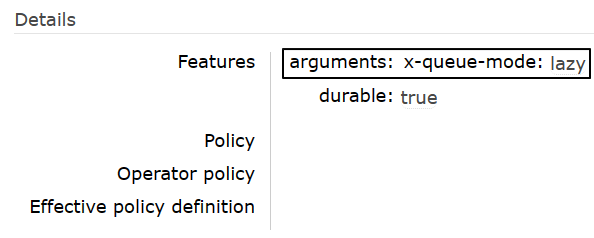一、创建惰性队列
1、官网说明

队列可以创建为默认或惰性模式,模式指定方式是:
- 使用队列策略(建议)
- 设置
queue.declare参数
如果策略和队列参数同时指定,那么队列参数有更高优先级。如果队列模式是在声明时通过可选参数指定的,那么只能通过删除队列再重新创建来修改。
2、基于策略方式设定
1
2
3
4
5
| # 登录Docker容器
docker exec -it rabbitmq /bin/bash
# 运行rabbitmqctl命令
rabbitmqctl set_policy Lazy "^lazy-queue$" '{"queue-mode":"lazy"}' --apply-to queues
|
命令解读:
rabbitmqctl命令所在目录是:/opt/rabbitmq/sbin,该目录已配置到Path环境变量
set_policy是子命令,表示设置策略
Lazy是当前要设置的策略名称,是我们自己自定义的,不是系统定义的
“^lazy-queue$“是用正则表达式限定的队列名称,凡是名称符合这个正则表达式的队列都会应用这里的设置
‘{“queue-mode”:“lazy”}‘是一个JSON格式的参数设置指定了队列的模式为"lazy”
–-apply-to参数指定该策略将应用于队列(queues)级别
命令执行后,所有名称符合正则表达式的队列都会应用指定策略,包括未来新创建的队列
如果需要修改队列模式可以执行如下命令(不必删除队列再重建):
1
| rabbitmqctl set_policy Lazy "^lazy-queue$" '{"queue-mode":"default"}' --apply-to queues
|
3、在声明队列时使用参数设定
- 参数名称:x-queue-mode
- 可用参数值:
- 不设置就是取值为default
Java代码原生API设置方式:
1
2
3
| Map<String, Object> args = new HashMap<String, Object>();
args.put("x-queue-mode", "lazy");
channel.queueDeclare("myqueue", false, false, false, args);
|
Java代码注解设置方式:
1
2
3
| @Queue(value = QUEUE_NAME, durable = "true", autoDelete = "false", arguments = {
@Argument(name = "x-queue-mode", value = "lazy")
})
|
二、实操演练
1、生产者端代码
①配置POM
1
2
3
4
5
6
7
8
9
10
11
12
13
14
15
16
17
18
19
20
| <parent>
<groupId>org.springframework.boot</groupId>
<artifactId>spring-boot-starter-parent</artifactId>
<version>3.1.5</version>
</parent>
<dependencies>
<dependency>
<groupId>org.springframework.boot</groupId>
<artifactId>spring-boot-starter-amqp</artifactId>
</dependency>
<dependency>
<groupId>org.springframework.boot</groupId>
<artifactId>spring-boot-starter-test</artifactId>
</dependency>
<dependency>
<groupId>org.projectlombok</groupId>
<artifactId>lombok</artifactId>
</dependency>
</dependencies>
|
②配置YAML
1
2
3
4
5
6
7
| spring:
rabbitmq:
host: 192.168.200.100
port: 5672
username: guest
password: 123456
virtual-host: /
|
③主启动类
1
2
3
4
5
6
7
8
9
10
11
12
13
| package com.atguigu.mq;
import org.springframework.boot.SpringApplication;
import org.springframework.boot.autoconfigure.SpringBootApplication;
@SpringBootApplication
public class RabbitMQLazyProducer {
public static void main(String[] args) {
SpringApplication.run(RabbitMQLazyProducer.class, args);
}
}
|
④发送消息
1
2
3
4
5
6
7
8
9
10
11
12
13
14
15
16
17
18
19
20
21
22
| package com.atguigu.mq.test;
import jakarta.annotation.Resource;
import org.junit.jupiter.api.Test;
import org.springframework.amqp.rabbit.core.RabbitTemplate;
import org.springframework.boot.test.context.SpringBootTest;
@SpringBootTest
public class RabbitMQTest {
public static final String EXCHANGE_LAZY_NAME = "exchange.atguigu.lazy";
public static final String ROUTING_LAZY_KEY = "routing.key.atguigu.lazy";
@Resource
private RabbitTemplate rabbitTemplate;
@Test
public void testSendMessage() {
rabbitTemplate.convertAndSend(EXCHANGE_LAZY_NAME, ROUTING_LAZY_KEY, "I am a message for test lazy queue.");
}
}
|
2、消费者端代码
①配置POM
1
2
3
4
5
6
7
8
9
10
11
12
13
14
15
16
17
18
19
20
| <parent>
<groupId>org.springframework.boot</groupId>
<artifactId>spring-boot-starter-parent</artifactId>
<version>3.1.5</version>
</parent>
<dependencies>
<dependency>
<groupId>org.springframework.boot</groupId>
<artifactId>spring-boot-starter-amqp</artifactId>
</dependency>
<dependency>
<groupId>org.springframework.boot</groupId>
<artifactId>spring-boot-starter-web</artifactId>
</dependency>
<dependency>
<groupId>org.projectlombok</groupId>
<artifactId>lombok</artifactId>
</dependency>
</dependencies>
|
②配置YAML
1
2
3
4
5
6
7
| spring:
rabbitmq:
host: 192.168.200.100
port: 5672
username: guest
password: 123456
virtual-host: /
|
③主启动类
1
2
3
4
5
6
7
8
9
10
11
12
13
| package com.atguigu.mq;
import org.springframework.boot.SpringApplication;
import org.springframework.boot.autoconfigure.SpringBootApplication;
@SpringBootApplication
public class RabbitMQLazyConsumerMainType {
public static void main(String[] args) {
SpringApplication.run(RabbitMQLazyConsumerMainType.class, args);
}
}
|
④监听器
1
2
3
4
5
6
7
8
9
10
11
12
13
14
15
16
17
18
19
20
21
22
23
24
25
26
27
28
| package com.atguigu.mq.listener;
import com.rabbitmq.client.Channel;
import lombok.extern.slf4j.Slf4j;
import org.springframework.amqp.core.Message;
import org.springframework.amqp.rabbit.annotation.*;
import org.springframework.stereotype.Component;
@Component
@Slf4j
public class MyLazyMessageProcessor {
public static final String EXCHANGE_LAZY_NAME = "exchange.atguigu.lazy";
public static final String ROUTING_LAZY_KEY = "routing.key.atguigu.lazy";
public static final String QUEUE_LAZY_NAME = "queue.atguigu.lazy";
@RabbitListener(bindings = @QueueBinding(
value = @Queue(value = QUEUE_LAZY_NAME, durable = "true", autoDelete = "false", arguments = {
@Argument(name = "x-queue-mode", value = "lazy")
}),
exchange = @Exchange(value = EXCHANGE_LAZY_NAME, durable = "true", autoDelete = "false"),
key = {ROUTING_LAZY_KEY}
))
public void processMessageLazy(String data, Message message, Channel channel) {
log.info("消费端接收到消息:" + data);
}
}
|
三、测试


